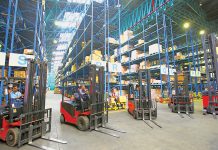COVID-19 has created an opportunity for e-commerce firms to ‘tap’ into a wider customer base. Dipanjan Banerjee, Chief Business Officer, Ecom Express in a conversation with CARGOTALK highlights efficient strategies to survive in today’s competitive environment and shares solutions to overcome existing impediments.
Ritika Arora Bhola
Elaborate on emerging trends impacting e-commerce fulfilment and how they are shaping the future of e-commerce logistics?
The ongoing pandemic triggered the e-commerce industry to expand towards new channels and consumer segments. It saw a paradigm shift towards e-commerce as an enabler for convenience, which became relevant to several individuals. It made way for customers to access a variety of products from within the four walls of their home and enabled firms to continue operations despite contact curbs. Some of these changes will likely be for the longer term, keeping in mind the new COVID-19 waves, new purchasing habits, and incentives for firms to capitalize on investments in new sales channels, resulting in shifts from brick-and-mortar retail to e-commerce. These factors have enabled a rise in the D2C segment. According to KPMG India, at present, 800 D2C brands are operating in India and the business may reach US$ 100 billion by 2025.
What last-mile delivery strategies have you developed to help you prevail in a DTC environment of fierce competition?
We offer both digital and logistics capabilities to support D2C businesses. Right from the onboarding stage, brands can sign up for our services through the ‘E-Zippie’ portal. The portal is a milestone in our efforts to provide a seamless experience for online businesses right from onboarding to fulfilling all shipping needs. We continue to enhance the experience of our customers by making logistics convenient for small and micro businesses by providing direct control of their shipments and flexibility in managing end-to-end shipment cycles. Our aim is to help them expand their market access to 27,000 PIN codes, diversify their customer base, and solidify their supply chain.
What are the key bottlenecks when it comes to managing returns during the peak season? How do you resolve the challenges?
Shipping during the peak season can be a challenge for online and digital commerce brands. Return shipping is a part of the overall e-tail experience, and with proper planning and collaboration with e-commerce focused logistics players, it is possible to control and provide a seamless process when it comes to returns. The volume of return shipments is estimated during the planning stage itself by forecasting with the help of data and trends, and we leverage analytics to understand return patterns. We plan for space and resource demand for peak seasons based on these insights. We work with our customers to plan the returns management as the goal is to use the returns as an opportunity to increase the e-commerce/online brand’s customer satisfaction. Our automated shipment sorters at return centres ensure quick processing of shipments for transit back to the portal’s warehouse/seller. Features such as proactive return updates reduce customer inquiries.
What is your outlook for 2022 and beyond?
The logistics market is expected to grow at a CAGR of 10.7 per cent between 2020 and 2024. The sector’s future will be data and technology driven. While the demand for field manpower will remain, the sector will see a lot of opportunities for niche skillsets around robotics, technology, data science and analytics.













